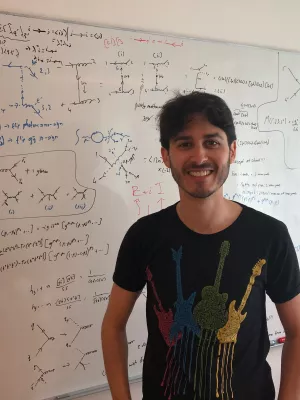
Andrew Lifson
Affiliated

The Chirality-Flow Formalism and Optimising Scattering Amplitudes
Author
Summary, in English
This thesis is composed of five papers, which all attempt to optimise calculations of scattering amplitudes in high-energy-physics collisions. These scattering amplitudes are a key part of theoretical predictions for particle-physics experiments like the Large Hadron Collider at CERN. The first four papers are the main topic of the thesis, and describe a novel method called chirality flow. Chirality flow simplifies Feynman-diagram calculations and makes them more intuitive. Papers I, II, and IV describe chirality flow in detail at both tree-level and one-loop level, while paper III shows a first implementation of it in the event generator MadGraph5_aMC@NLO. The final paper instead explores the speed, accuracy, and precision of an approximation of the colour part of a scattering amplitude.
Paper I introduces the chirality-flow formalism, a new pictorial method used to calculate tree-level helicity amplitudes by drawing lines and connecting them to find spinor inner products, instead of doing algebraic manipulations. This method makes calculations more transparent, and often allows one to go from Feynman diagram to spinor inner products in a single line. Massless QED and QCD are treated in full.
Paper II extends the chirality-flow formalism of paper I to deal with massive particles, and therefore allows chirality flow to be used for any tree-level Standard Model calculation.
Paper III describes our implementation of chirality flow in massless QED in MadGraph5_aMC@NLO. A speed comparison is made showing up to a factor of 10 increase in evaluation speed.
Paper IV extends the chirality-flow formalism to the one-loop level for any Standard Model calculation, showing the simplifications in the numerator algebra and the tensor reduction.
Paper V describes an extension to the MadGraph5_aMC@NLO event generator in which the kinematics are calculated using Berends-Giele recursions instead of Feynman diagrams, and the colour matrix can be expanded in the number of colours Nc. The speed of the extension, and the accuracy and precision of the colour expansion are explored.
Paper I introduces the chirality-flow formalism, a new pictorial method used to calculate tree-level helicity amplitudes by drawing lines and connecting them to find spinor inner products, instead of doing algebraic manipulations. This method makes calculations more transparent, and often allows one to go from Feynman diagram to spinor inner products in a single line. Massless QED and QCD are treated in full.
Paper II extends the chirality-flow formalism of paper I to deal with massive particles, and therefore allows chirality flow to be used for any tree-level Standard Model calculation.
Paper III describes our implementation of chirality flow in massless QED in MadGraph5_aMC@NLO. A speed comparison is made showing up to a factor of 10 increase in evaluation speed.
Paper IV extends the chirality-flow formalism to the one-loop level for any Standard Model calculation, showing the simplifications in the numerator algebra and the tensor reduction.
Paper V describes an extension to the MadGraph5_aMC@NLO event generator in which the kinematics are calculated using Berends-Giele recursions instead of Feynman diagrams, and the colour matrix can be expanded in the number of colours Nc. The speed of the extension, and the accuracy and precision of the colour expansion are explored.
Department/s
- Theoretical Particle Physics - Has been reorganised
- Particle and nuclear physics
Publishing year
2023-03-27
Language
English
Full text
Document type
Dissertation
Publisher
MediaTryck Lund
Topic
- Subatomic Physics
Keywords
- Spinor-helicity formalism
- Chirality-flow formalism
- Helicity amplitudes
- Standard Model
- QED
- QCD
- Optimisations
- Colour expansion
- Phenomenology
- Fysicumarkivet A:2023:Lifson
Status
Published
Project
- The Chirality-Flow Formalism and Optimising Scattering Amplitudes
Supervisor
- Malin Sjödahl
- Rikkert Frederix
- Stefan Prestel
ISBN/ISSN/Other
- ISBN: 978-91-8039-588-5
- ISBN: 978-91-8039-589-2
Defence date
26 April 2023
Defence time
10:00
Defence place
Lundmarksalen, Astronomihuset, Sölvegatan 27, Lund.
Opponent
- Dieter Zeppenfeld (Professor)

